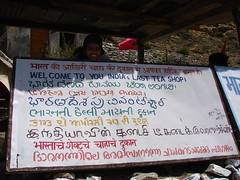Let’s first put a few realities on the table. Not many tourists have Arunachal Pradesh on their travel agenda. Which is just as good for those of us who want to keep their special discoveries all to ourselves!
Tag Archives: Lohit
Wakro – a Prelude
Bridges of Arunachal Pradesh
In the 1992 best seller, ‘Bridges of Madison County’, when National Geographic photographer Robert Kincaid drives his pickup truck through the hot and dusty dirt tracks of Iowa and turns into Francesca Johnson’s farm driveway looking for directions to the Roseman covered bridge, little did I know about the beauty and romance of the bridges of Madison county that would haunt me forever.
I found the same beauty and romance in the bridges of Arunachal Pradesh too.
Arunachal Pradesh: the land of the dawn-lit mountains, the land of the Hoolock Gibbons, the land of the Mishmi’s, Adi’s, Tani’s, Nishi’s and many other indigenous tribes, and the land of the fiesty Lohit river.
Someone had said that ‘Bridges are perhaps the most invisible form of public architecture’. But not in Arunachal Pradesh.
Bridging rivers, gorges, and valleys bridges have always played an important role in the history of human settlement by not only providing crossings over water, dangerous roads and cliffs, but also becoming ‘frames for looking at the world around us’.
The beauty of each bridge that we crossed in Arunachal Pradesh was inspiring. Each one had its own unique character. Whether we were driving or walking over them or passing under them, we were enamored by the beauty of the surroundings. Some of bridges were monuments on their own.
Some of the hanging bridges we crossed were made of bamboo and wooden planks, apart from the metal cables that ran along the side and connected them to the ends. The floor creaked and squeaked, the entire bridge sometimes swinging under our clumsy steps. Below, through the gaps of missing wood pieces, we could see the mighty turquoise Lohit river gushing and rushing loudly, leaving us breathless.
And then you see school children running across barefoot, mothers with small babies on their back, villagers carrying loads of whatsnot in their bamboo baskets, looking at us suspiciously. Well, practice does make one perfect. But what about fear of heights. Must be non-existent in these places.
A lot of the modern bridges in Arunachal are built by the Indian army and Border roads organisation.
Metal and concrete structures that are built to withstand the rains, landslides and the heavy army trucks. Though they do not have the beauty of the hanging bridges, they do serve their purpose.
Have you heard about bridges that are not built? Bridges that are grown.
Maybe, some other time….






































